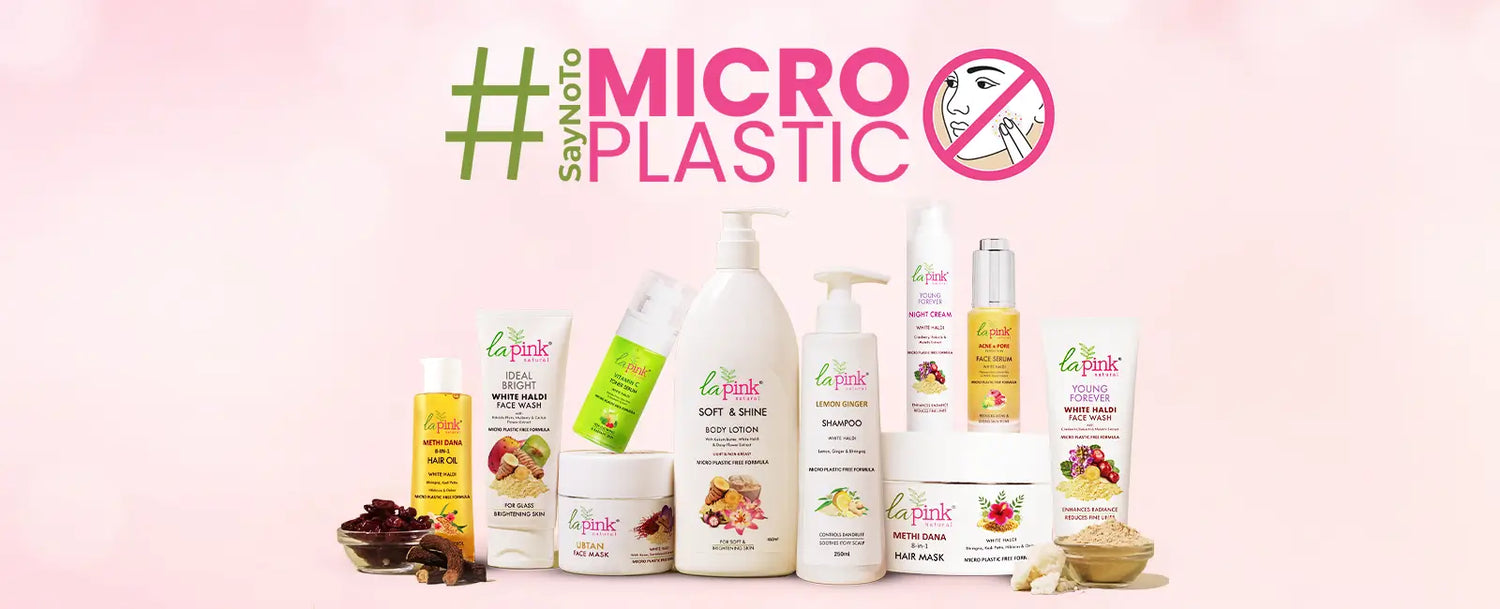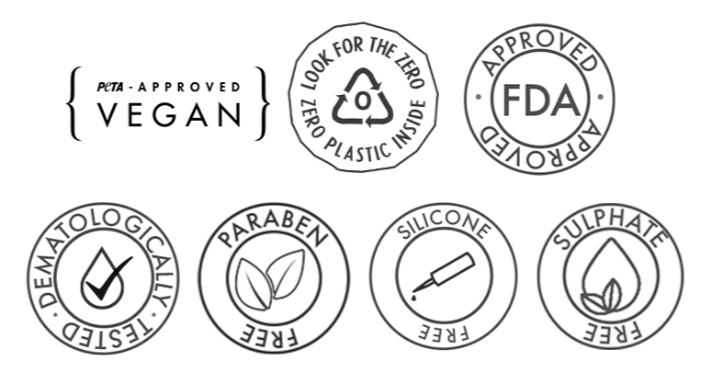#SayNoToMicroplastic : An initiative to go with 100% Microplastic Free Beauty
Applying face creams as a part of a skincare ritual is equivalent to slathering your face with trash more than any marketed nutrients. Sounds weird? It felt the same to us when our founders found out about the presence of different types of microplastics in cosmetics. Not only does it come out as a devastating ingredient used in cosmetics but the number of skin diseases tags along. Microplastics have long been used widely in the cosmetic industry and are a less-spoken topic worldwide. With #SayNoToMicroplastic we at La Pink, are initiating a step to bring a revolution in the beauty industry and awareness among consumers that skincare is beyond just the ingredients, it is more about the science functioning for it. Our 100% Microplastic Free Formulation used in the La Pink products justifies the intent.

You put about 90,000 plastic particles on your face every time you use anti-wrinkle cream. In the era of consumers who like to make informed decisions about everything they choose to do, it is sad to admit that there is still not much information and awareness about ‘Microplastics’ in our personal care products. As soon as we hear the word, we think of it as minute or microscopic particles of plastic or plastic packaging in general. But microplastics in cosmetics has been there in the industry for a long time.
So what are Microplastics?
The meaning of Microplastics is defined as tiny synthetic polymer or liquid plastic particles added in personal care products primarily to maintain the desired consistency of the product. It often serves as an exfoliant, a bulking agent, to extend shelf life, or for the controlled release of active ingredients.
How Microplastics are different from microbeads?
Microplastics are widely used as a thickening agent in cosmetics, toothpaste, etc in liquid form whereas microbeads, or ‘Tiny plastic balls or crystals’ present in the scrub, are used for exfoliation. How to identify that? You can check for tiny particles in blue, red, and orange.

Why should you be concerned as a consumer?
The internet is flooded with information about the impact of microplastics on the environment but very little information on the impacts of microplastics on skin. It seemed like a challenge when La Pink’s founders decided to bring a whole range of microplastic-free products but the team knew what they were headed for and determined that the change was necessary. To back the idea for its execution, countries like Germany and Korea announced the ban on microplastics stating the reasons related to adverse impacts on health and the environment.
#SayNoToMicroplastic aims to bridge the knowledge gap amongst consumers about the presence of Microplastic in wellness products, its threatening effects on our body and skin, and how to identify those red flags.
Manufacturing microplastic free products may cost heavy on the pocket production wise but it won’t harm the skin, health or even the environment.

Microplastics:
Defining microplastics is the most important aspect of such a campaign as it could ensure a better understanding and reduced use of microplastics. In cosmetics, “microplastic” refers to all kinds of synthetic polymers (smaller than 5mm) that are intentionally added to cosmetics and personal care products. They are usually used as cheap fillers or emulsifying agents.
One thing we need to understand is that Microplastics in wellness products are not limited to microbeads. The term ‘microplastic’ is not consistently defined but is considered to refer to small, liquid, biodegradable or mostly nano-sized particles made of a synthetic polymer. They are used in both leave-on and rinse-off products in cosmetics and personal care products. From shampoos and sunscreens to make-up and deodorants, microplastics are used in every kind of product. You would be surprised to know the presence of microplastic in makeup products, which is why it is important to understand the need of microplastic free makeup as well.

What can microplastics potentially do to our skin?
There is no limit to the harm, or damage when it comes to the use of microplastic in skin care products, it can cause from mere itching and irritation to literal cancer and tissue disruption. Microplastic can penetrate our skin and mess with hormones to cause disruption internally, which may not be visible externally at the initial point in time.

Skin Irritation: Some may experience skin irritation from chemical additives and preservatives used in conjunction with liquid microplastic which can lead to skin irritation and redness and even cancer.

Sensitivity: People with sensitive skin may be more prone to adverse effects of microplastics, which can exacerbate conditions like eczema and dermatitis.

Skin Barrier Disruption: Microplastics in liquid form can interfere with skin’s natural barrier function. This can make skin more susceptible to environmental pollutants and allergens potentially leading to more skin sensitivity.

Chemical Absorption: Microplastics can carry and release harmful chemicals, such as phthalates and bisphenol A (BPA). These chemicals can get absorbed through our skin and may cause long term health conditions and hormone disruption.

Bioaccumulation: There is concern about the bioaccumulation of microplastics and their associated chemicals in human tissues, which could clog the way of skin and prohibit it from breathing.
Urgency?
The question that must be arising to your mind now is, if microplastics are so harmful to our skin and body, why do companies still use them?
- First and the foremost reason is PROFIT. It should come as no surprise that the harsh reality of this world is that no one cares about concerns related to our health or the environment, all they care about is profitability. Microplastics are cheap whereas the alternatives are relatively expensive and not readily available in the market.
- Lack of research and development: again, R&D costs resources and time. No established brand cares to invest when they can easily greenwash you.
- Lack of awareness among consumers: The fact that people in India are easy to manipulate with promising words like “eco-friendly”, and “skin friendly”. There is a major knowledge gap that is yet to be filled (we better not use plastic fillers), companies should offer transparency and consumers should open their eyes and read labels to identify red flags.
- Tradition: companies often give the excuse that it has been used for many many years, but we should understand that the lifestyle has changed drastically, we use products more than ever! Various kinds for various parts. So if this usage tradition can change, why can’t we change the application tradition?
Why is it coming up now?
Everyone nowadays has a “skincare regimen” or “everyday makeup routine” which they follow religiously. An interesting thing that is worth noting is that even our Grandma and Ma also had their me-time, BUT - Was it as often? Were their products different? Were there environmental differences? The answer is YES. The products were mostly natural and freshly made, the environment was cleaner, and plastic consumption was minimal.
Times have evolved and lifestyles have changed. The sad part is that our products have also changed and became worse - often a laminating layer to the skin, affecting us more than ever because of the frequency of usage and various sources of microplastic contacting our skin, making it more concerning than ever. So, in fact it is the best time to highlight the urgency of the issue and seek immediate solutions.
What can decision-makers do?
- Invest in Research and Development: Recognise the scientific evidence on the adverse effects of microplastics on human health and the environment and find the best possible alternatives of microplastic that they can use. This should not be delayed any further.
- Build Transparency: Make the information readily available, be it research papers, ingredient lists, or manufacturing processes. Everything should be accessible and understandable to the consumer. Show more accountability to the consumers.
- Refrain from making false green claims: Make sure to provide all the evidence to support the environmental benefits that your product claims.
What can we as consumers do?
Demand Transparency: Use your Right to Information and ask your favorite brand to prove the claims that they make. You have the power to make companies accountable and encourage them to make changes as per your needs.
Read Labels and Educate Yourself: Use available resources to learn about the problems they are targeting and the ingredients they are using to solve them. Research about each ingredient and their effects on our skin or body.
Make your voice heard: Let the decision makers know what you want and what you don’t, and let them know that you strictly reject microplastic in your product. Spread awareness through word-of-mouth and make the right use of your power and social media.
#SayNoToMicroplastic campaign is designed with the single aim of developing awareness about the use of microplastic so much that the common man should know that they are using just plastics in the name of skin-loving or beneficial ingredients for skin when the reality is far away from what it seems.
WHY TRUST LA PINK?
La Pink is proud to present a range of 100% Microplastic-Free Formulated beauty products that are specially made for the skin and maintain its natural texture without having to invest thousands. Our products have ingredients that are sourced from different parts of the world making White Haldi a common ingredient because of its 20X more potency than yellow turmeric.
Read more about La Pink and its journey here.







